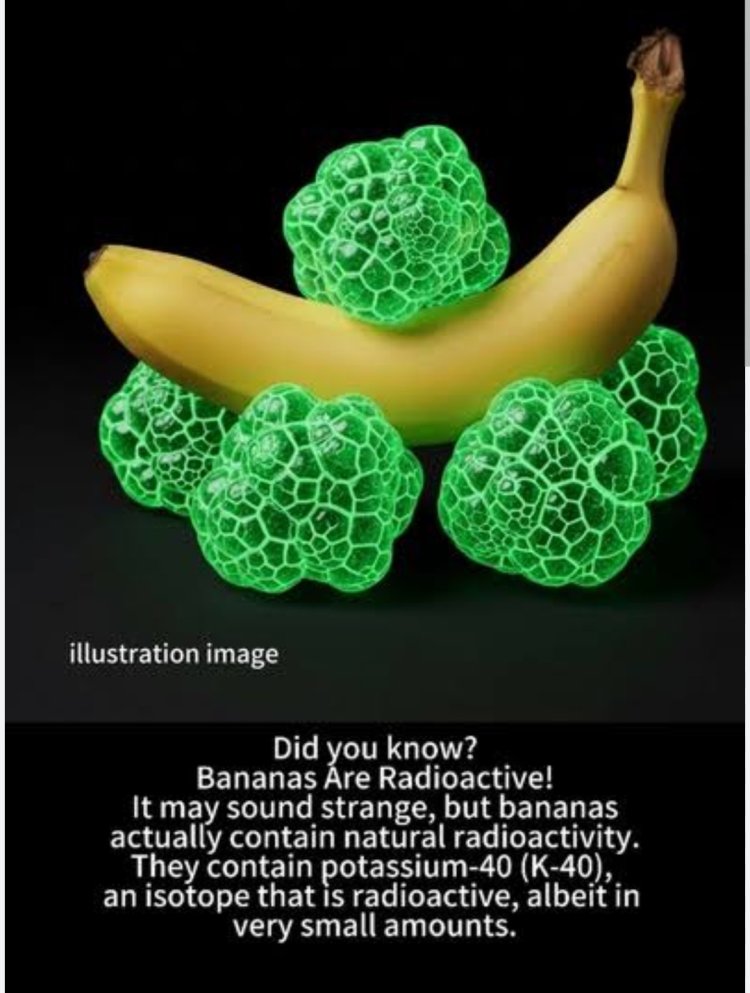The science behind fruit's atomic secret
A banana radioactive is a perfect of how science hides in plain sight.

Bananas Are Naturally Radioactive.
When you peel a banana for breakfast, the last thing on your mind is radiation. Yet this everyday fruit hides a little-known fact: bananas are naturally radioactive. Don’t panic—this doesn’t make them dangerous. In fact, the reason is entirely natural, tied to the chemistry of life itself.
The Element Behind the Glow: Potassium
Bananas are famous for being rich in potassium (K)—an essential mineral for human health. Potassium regulates nerve function, muscle contraction, and fluid balance in our bodies.
But here’s the catch: not all potassium atoms are identical. In nature, potassium exists in three forms, called isotopes:
1. Potassium-39 (stable) – About 93% of natural potassium
2. Potassium-41 (stable) – About 6.7%
3. Potassium-40 (radioactive) – Only 0.012%
It’s that last one, potassium-40, that makes bananas ever so slightly radioactive.
Why Potassium-40 is Radioactive
Potassium-40 () is unstable, meaning its atomic nucleus can spontaneously change into another element through radioactive decay. It primarily decays in two ways:
Beta decay – An electron is emitted, turning potassium-40 into calcium-40.
Electron capture – The nucleus captures one of its own electrons, turning potassium-40 into argon-40.
These processes release energy in the form of radiation, which is why potassium-40 is classified as radioactive.
How Much Radiation Are We Talking About?
The amount of potassium-40 in a banana is tiny—about 15 becquerels (Bq). A becquerel means one radioactive decay per second. That sounds like a lot, but compared to everyday background radiation, it’s negligible.
For perspective:
Eating one banana = about 0.1 microsieverts (µSv) of radiation.
The average person gets 2,400 µSv/year from natural sources.
You’d need to eat 10 million bananas at once to get a lethal dose of radiation.
In other words, bananas are technically radioactive, but they’re about as threatening as a candle in the sun.
The “Banana Equivalent Dose”
Because of their predictable potassium-40 content, bananas have become an informal scientific reference for explaining small amounts of radiation.
Scientists sometimes use the Banana Equivalent Dose (BED) to help people grasp radiation exposure. For example:
A dental X-ray = about 50 BEDs
A flight from New York to London = about 800 BEDs
Of course, BED isn’t an official safety measure—it’s more of a playful educational tool.
Why Bananas Aren’t Alone
Bananas aren’t the only radioactive food. Many plants absorb potassium-40 because potassium is a vital nutrient. Some other radioactive edibles include:
1.Brazil nuts (contain radium)
2.Carrots and potatoes (also rich in potassium)
3.Red meat and beans (potassium and carbon-14 content)
The difference is that bananas have enough potassium for the radioactivity to be noticeable—at least to a sensitive Geiger counter.
Why You Shouldn’t Worry
Radiation often gets a bad reputation because of its association with nuclear accidents or medical risks. But in reality:
Radiation is everywhere – from cosmic rays in space to minerals in the ground.
Our bodies are adapted to handle small doses.
Potassium-40 is not something we can avoid—it’s in every living cell, including our own.
In fact, if you removed all potassium from your body to avoid radiation, you’d also remove your ability to live.
Bananas in Pop Culture and Science Jokes
The quirky fact of banana radioactivity has led to plenty of science humor:
Physics professors joke about “eating your daily dose of radiation”.
Nuclear engineers sometimes calibrate radiation detectors using bananas.
Some security scanners at ports have mistaken banana shipments for suspicious radioactive cargo.
Final thought.
A banana’s radioactivity is a perfect example of how science hides in plain sight. It reminds us that radiation isn’t just a human-made hazard—it’s a natural part of our world, woven into the chemistry of life. So next time you snack on a banana, you can smile knowing you’re holding a piece of fruit with an atomic secret… and you’re perfectly safe enjoying it.












